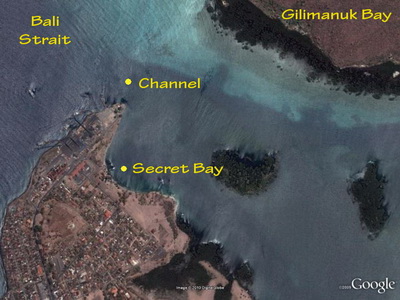
The best description I have heard of for Secret Bay is in David Pickell and Wally Siagian’s revised second edition of Diving Bali where Pickell uses the descriptor “refugium” to explain the diversity of Secret Bay.
I had to look it up in the dictionary, but it means “an area where special environmental circumstances have enabled a species or a community of species to survive after extinction in surrounding areas”.
But in the aquarium world they use the term to describe a special area of the fish tank that has been set-up as a refuge from predation, which I think describes the overall situation at Secret Bay much better.
Gilimanuk Bay is quite large and measures roughly 3km long by about 1km wide, but it’s very shallow and has an average depth of around 5m.
The nearby Bali Strait on the other hand, is 3km wide & around 60m deep, with the rich waters of the Indonesian Throughflow roaring through at currents that reach up to 7 knots.
The entrance to Gilimanuk Bay is just over 600m wide, but the shallow reef on the northern side means that a third of that is taken up by the 8-10m deep channel that directs the flow of water from the Bali Strait into the bay.
It is this water, rich with plankton & other nutrients, that feeds & nourishes the inhabitants of Secret Bay.
There is much to see underwater, but it’s very much a muck diving & critter site – so bring your macro lenses!
Secret Bay Underwater Image Gallery
Diving Bali: The Bobbit Worm & Secret Bay
Secret Bay is, in my experience, one of the best places in Bali to see the rather mysterious and hard to find Bobbit Worm.
The Bobbit Worms are to be found in the sea grass at the western end of the bay, about a 100m or so from the changing area entry point and in 3-4m of water.
The local guides look for tell-tale depressions in the sand in that area, which indicates a possible Bobbit Worm location, and then use a tried & tested method of enticing the worms from their home deep in the sand. Grilled fish kebabs are the weapon of choice and are held just above the sand at the depression to tempt the worms out, striking at lightning fast speed when they do. Then by carefully wafting the stick back & to the guides tempt the worm further out into the open so they can be photographed in all their glory!
Secret Bay Bobbit Worm Image Gallery
Diving Bali: Diving Secret Bay
Secret Bay is very much a muck dive, so if blue water and coral reefs are your thing – just don’t bother. But if you like the weird & wonderful critters that muck diving offers, then it’s well worth the journey. The cool waters from the Bali Strait mean that you will definitely need a wetsuit and I personally use a 5mm suit as the shallow depth means that extended bottom times apply and it’s easy to get cold.
Diving Secret Bay is very easy as it’s a shallow shore dive with no significant dangers apart from watching what you kneel on. If you are only doing a couple of dives at Secret Bay a dive guide is definitely recommended as they will be able to show you the best areas to dive and also where the critters are.
Diving Bali: When to Dive Secret Bay
Being such a sheltered location the main variable regarding when to dive Secret Bay is the state of the tide and a rising tide will provide the best visibility. But the site can still be dived at low tide, it just means the depth will be less and the viz will not be the best.
Back To: Scuba Diving in Bali
